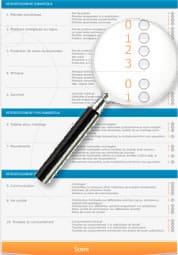Osteoarthritis is, by definition, a disease that creates painful functional impairment limiting usual activities until it becomes a real handicap.
To guide treatment, assessing pain is an essential step in the management of the disease.
But pain is subjective which makes measuring it quite difficult: It is preferable that it be done by the patients themselves to avoid the risk of the doctor underestimating it. Hence the interest of a self-evaluation method which, to be valid, must be quick and easy to understand, applicable to a wide public and reproducible for a given patient and easy to use.
Visual Analogue Scale (VAS)

The VAS is a sensitive self-evaluation scale which is reproducible and reliable and validated for acute or chronic pain. Its use allows not only to quantify the pain but also to measure its relief.
It is in the form of a two-sided strip with a scale ranging from "no pain to worse pain" on the patient side and graded* from 0 to 10 on the caregiver side. The patient points to what he considers to be his pain level and the caregiver measures the corresponding intensity.
Its use is only possible for patients capable of communicating in an abstract way. It requires time to explain to patients and one measurement for each painful area.
The VAS has its limitations in people, mostly elderly, with cognitive or visual impairment or a limited capacity for understanding the instructions.
Here we offer you an electronic VAS to use on your screen during your consultations.
Click on the link below to open the patient side. Let him click on what he considers his level of pain: the scale will present you with the rating obtained.
* The size of the strip, normally equal to 10 cm, does not influence the result. Ref. Kempf C et al. Measurement of pain intensity using a visual analogue scale on a hand-held computer = Measuring pain intensity with a visual analogue scale on a miniature electronic scale. Douleurs (Pain), 2001, vol 2, n°5 pp 221-225.
The DOLOPLUS 2 scale - evaluating pain in the elderly
The high prevalence of pain in the elderly is a concept that nowadays is perfectly accepted. The proportion of elderly people with chronic pain is about 60% of which one third is suffering from severe pain; a prevalence which can reach 80% by the end of life.
But while self-assessment of pain is the most appropriate method to address the risk of underestimation by the caregiver, it shows its limitations in elderly patients:
- capacity for abstraction that is often insufficient for a VAS (strip-cursor-pain-intensity-rating) or a vocabulary scale;
- memory problems making it difficult to use the verbal scale that compares two feelings at different times
- lack of sensitivity or specificity related to fear of disturbing or prejudice extending more to the consequences of the pain rather than its actual intensity, overestimation in cases of anxiety…
Hence the use of a behavioural pain assessment scale in the elderly with impaired verbal communication. DOLOPLUS 2 is an observation sheet with 10 items (5 somatic reactions, 2 psychomotor reactions and 3 psychosocial reactions, each rated from 0 to 3).
A score ≥ 5 out of 30 indicates the presence of genuine pain.
Here we offer you an electronic format of this scale for you to use during your consultations. Click on the link below to open the scale and tick the answers directly on the screen to calculate the score for your patient.
Doloplus instructions for use:
"Any changes in behaviour in the elderly should suggest pain"
- Usable in healthcare facilities or at home; at home rely on family and others after entering the scale in the patient's follow-up record.
- Do not score if the item is inappropriate: it is not necessary to have a response to all the items on the scale.
- Compile score kinetics (like temperature or blood pressure) to monitor the evolution of the pain.
- If the patient is communicative and cooperative, it is logical to use the self-assessment instruments.
Doloplus lexicon:
- Somatic complaints: pain expressed by word, gesture, cries, tears or moans.
- Protective body postures adopted at rest: unusual body positions intended to avoid or relieve pain.
- Protection of sore areas: a defensive attitude.
- Expression: the facial expression appears to express pain, as does the gaze.
- Communication : may be verbal or non-verbal..
- Problems of behaviour: Aggressiveness, agitation, confusion, indifference, lapsing, regression, asking for euthanasia, etc.
Bibliography
- Anaes. Évaluation et prise en charge thérapeutique de la douleur chez les personnes âgées ayant des troubles de la communication verbale. Octobre 2001.










